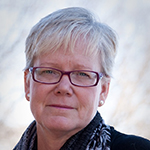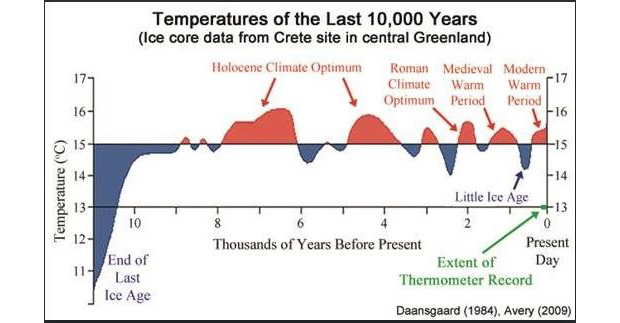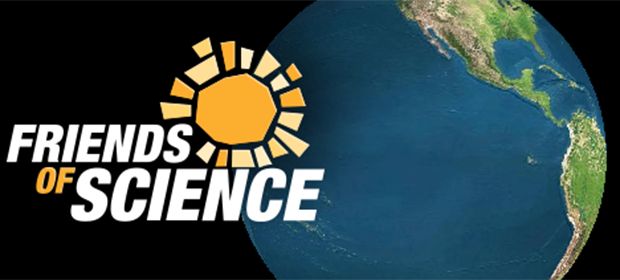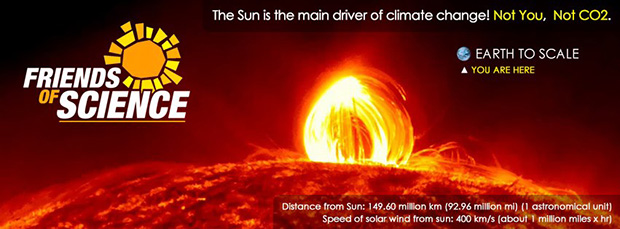Friends of Science Society is a non-profit society that does critical review of climate change science and related energy policies. Below is our recent interview with Michelle Stirling, from Friends of Science:

Q: For those who haven’t heard of it, what is the best way to describe Friends of Science?
A: We started in 2002 with a group of earth, atmospheric, solar scientists and Professional Engineers who questioned the science and the costs/effectiveness of the Kyoto Accord. We’re still asking the same questions – the more recent Paris Agreement and Green New Deal are simply variations on the old Kyoto theme.
Few people realize that Kyoto was largely driven by Enron which was looking for a money-maker on emissions trading, it was not really about climate change or saving the planet. The effort to establish a global emissions trading plan has been perpetuated by the ClimateWorks Foundation and its green billionaire partners, as Dr. Matthew Nisbet discusses in his paper on the post cap-and-trade era.
Unfortunately, this business model relies on a product ‘whose value lies in its absence’ or as Mark Schapiro described it in Harper’s Magazine in Feb. 2010, “the lack of delivery of an invisible substance to no one.” This does not seem to be a sustainable business model as it relies on promises by businesses to emit less greenhouse gases than they might otherwise have done in the future, and there is no value-added product stream.
Q: Is there a connection between climate change and weather extremes?
A: Extreme weather events are an integral part of climate. Climate scientist and policy analyst Roger Pielke, Jr. has written an excellent book called “The Rightful Place of Science: Disasters and Climate Change,” showing evidence that there are no trends to more extreme weather. Despite what you hear about rising costs of extreme events, when properly calculated, the costs as a fraction of wealth are the same or less than past impacts of extreme weather events. Damages from extreme weather events increase only because we build more expensive assets in vulnerable locations. There’s certainly much more media coverage! Years ago, we did not have live cellphone or weather network broadcasts of extreme weather events. People only found out about such events days or weeks later, by which time it was a blip in what was then a very limited news cycle.
Dr. Madhav Khandekar did a whole presentation on this topic at our 15th Annual Event in 2018 entitled: “Climate Change and Extreme Weather: Perception vs Reality.”
People get confused and ascribe everything about climate and weather to human influence. The scientific definition of climate change of the IPCC refers to any change in climate, whether caused by human influence or natural variabilities, that can be statistically measured over long periods of time (i.e. 30, 50, 100 and millennial time scales). The political definition of the UNFCCC climate change includes value judgements and finger-pointing at humans; it refers to ‘dangerous’ change in atmospheric concentrations of greenhouse gases due to human activity (typically pinned on fossil fuel use and carbon dioxide). However, the IPCC report of 2013 showed that carbon dioxide concentrations had risen, but temperatures had flatlined for then 15 years – now 18 years to the 2016-17 El Nino based on satellite temperature data of the lower atmosphere. This means carbon dioxide emissions are not the ‘control knob’ that can fine tune climate and Mother Nature seems to be the more influential force. Roger Pielke, Jr. wrote a paper in 2005 on how these two definitions result in very different climate policy options.
Sadly, the media and environmental groups are literally scaring people to death, when climate change is a fact, but we have always adapted, and we should be prepared for warming or cooling. Cooling causes more erratic weather.
Q: How much hotter has the world got – and how hot will it get?
A: The so-called “Current Warm Period” began in about 1860, which was the end of the Little Ice Age. In the Little Ice Age, a period of about 500 years, temperatures dropped at least 1 degree Celsius (1.8 degrees Fahrenheit). Weather became very erratic. There were five years of almost non-stop rain at the start of the Little Ice Age in England and much of Europe (William Rosen “The Third Horseman”). Crops failed. Famines and civil unrest were common. The weather patterns were so frightening, that people were burned at the stake as witches for the crime of ‘weather cooking with the help of Satan’ as Dr. Sallie Baliunas explains in a video. Toward the end of this period, in the late 1700’s, there were a number of large volcanic eruptions that had a significant impact on earth’s climate. The 1783 Laki volcanic eruption and its toxic cloud of gases killed thousands of people – through direct contact in Iceland and from a low-lying toxic gas cloud reaching England, and indirect outcomes like crop failures. Oregon State University reports that following the Laki eruption, “In the eastern United States, the winter average temperature was 4.8 degrees C below the 225-year average.”
But from about 1860, volcanic activity dropped off and we entered a warming period. This is all part of a cyclical pattern, well known through human historical records and geological evidence. In the current period, the global average temperature is estimated to have risen about 0.8° Celsius. However, this is in line with previous warm periods. Furthermore, people should realize that the global average temperature is a ‘metric’ – it is not an actual temperature reading. A paper by Essex and McKitrick discusses the curious nature of temperature. A NASA GISS commentary discusses “The Elusive Absolute Surface Air Temperature.”
In the past three years, we’ve actually had a drop of about 0.5C in temperature – however, we need a few more years of data to see if this is a trend or not.

Q: What should we all know about climate change?
A: First of all, people should know that there are many natural cyclical patterns of solar cycles, ocean currents and atmospheric oscillations (like El Nino and La Nina) that most affect climate. It has been much hotter in the past and much cooler, without any human influence. We do not have long-term data on many of the natural cycles, though climate changes and solar sunspot activity have been tracked and observed for 400 years (low sunspot activity seems to be a harbinger of cooling, though the mechanism is not clear). There are many ‘internal’ earth variables, like tectonic plate movement, volcanic eruptions, sea ice variability, which are not well understood, either. All of these interact in a ‘wicked’ complex, chaotic mix. Human effect on climate has been deemed to be nominal compared to Mother Nature, since the 2013 IPCC AR5 report, as discussed by Dr. Judith Curry in her US Senate testimony.
Secondly, humans do affect regional climates and we are adding additional greenhouse gases to the atmosphere. One effect is that the earth has been ‘fertilized’ and there’s been much more plant growth worldwide. People need to know that carbon dioxide is at a very low level of concentration in the atmosphere today, compared to earth’s history. Without it, all the plants would die and so would we, because plants make oxygen for us from the carbon dioxide that they use in photosynthesis. Today, the scientific consensus is that carbon dioxide’s effect on warming is nominal. Emeritus Prof. François Gervais explains this in a video on our YouTube channel. There was a period from about 1970 to 1990 when a rise in carbon dioxide concentration and warming temperatures seemed to rise in lockstep. That’s why people assumed carbon dioxide drove warming (though most geologists and solar physicists did not agree with that view). In the 4.5-billion-year geologic time scale, carbon dioxide concentration and temperature rise/fall are not correlated.
Humans do affect regional climates by building cities (that creates an ‘Urban Heat Island”), by damming and diverting rivers or draining large water bodies (like Owen’s Lake in California – a lake for 850,000 years, drained dry in the space of a decade by diverting tributaries). Humans cut large swaths of forests and cultivate large areas of land. Roger Pielke, Sr. has done a lot of research on these human influences on climate change.
Thirdly, a carbon tax is not going to ‘save the planet’ and neither are wind and solar farms, as Bill Gates recently said. Wind and solar cannot support basic society as Professor Kelly explains. The planet will do just fine, but humans have many real, practical issues we should address like wastewater treatment, arable land that needs restoration, and noxious pollution – especially in developing countries. We know how to mitigate our impact and we should concentrate on these as S.M.A.R.T. goals. Such a focus would truly benefit the environment and the climate. That’s what we recommend in our rebuttal to the IPCC SR15 report: “Faulty Premises = Poor Public Policy on Climate.”
Finally, people should know that skeptics who question the so-called ‘consensus’ are engaging in responsible conduct in research. “Science has progressed through a uniquely productive marriage of human creativity and hard-nosed skepticism, of openness to new scientific contributions and persistent questioning of those contributions and the existing scientific consensus.”
Q: Will the actions we take today be enough to impact climate change, or is it too late?
A: In our view, the sun is the main direct and indirect driver of climate change. The claim that humans can control the climate by reducing carbon dioxide emissions is really just the premise for creating a cap and trade system and carbon taxes, which would underwrite more wind and solar farms for green crony capitalists. We have seen in Europe that such policies have decimated the poor and middle class. Industry has moved offshore to places with no such regulations. Vaclav Smil is an expert on energy matters and Bill Gates’ favorite author on the topic. Smil debunks the myth of “Energy Revolution? More like a Crawl.” People are used to hi-tech rapid advances, but the physics of hi-tech and energy production are entirely different, as Mark P. Mills explains in “Inconvenient Energy Realities.”
We hope that people will calm down, have a look at historical climate changes and appreciate that we humans are not gods who can make climate change to be what we want it to be. There is no ‘climate safe’ world – if anything, the fact that we now have abundant fossil fuels and modern technology will allow us to prepare and adapt for a potential cooling period that many solar physicists are predicting. The sunspot activity has been very low for the past few years. Some scientists even say “The New Little Ice Age Has Started.”
 Recommended: An Interview With Jan Bindig, CEO From DATARECOVERY, Leipzig – Germany
Recommended: An Interview With Jan Bindig, CEO From DATARECOVERY, Leipzig – Germany
Q: What can we expect from Friends of Science in the future?
A: Friends of Science Society will continue to review climate science papers and related energy policies and issue commentaries and critiques. We have a new plain language website called: “ClimateChange101.ca” which is in English and French. We will continue to host our annual events. One of our first big projects was the documentary “Climate Catastrophe Cancelled” – which is even more pertinent today. Friends of Science Society supports open, civil debate on climate and energy policies. Freedom of speech and freedom of the press are essential for proper scientific inquiry. We welcome new members and donors who support our cause – Join or donate here(turn off your ad blocker. Note are a Canadian non-profit society, not a charity, and cannot issue tax receipts.).
Activate Social Media:


 Recommended:
Recommended: 